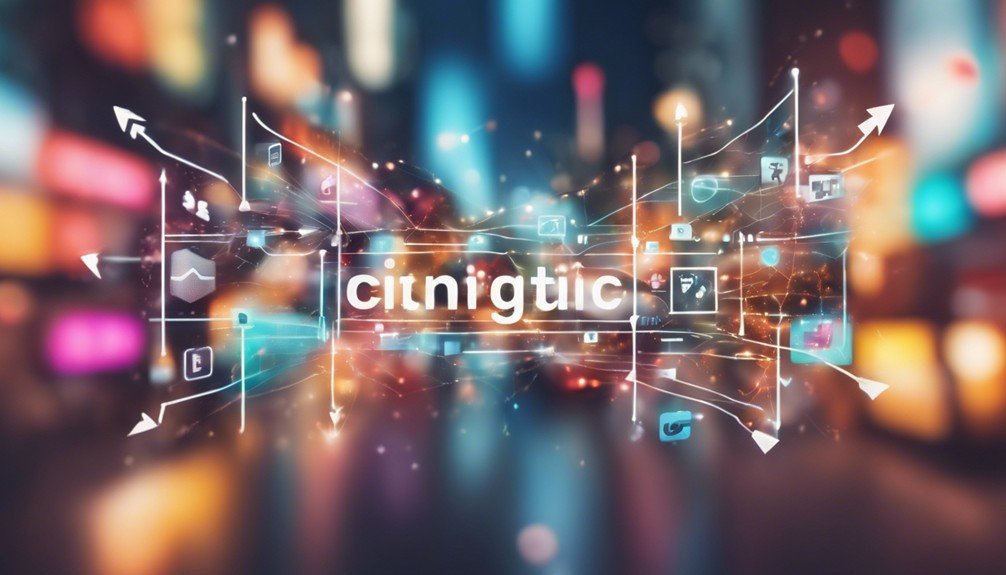To boost your digital marketing with omnichannel strategies, focus on creating a seamless experience across all touchpoints, enhancing customer satisfaction and loyalty. Understand the customer journey and leverage data analytics for personalized interactions. Integrate both online and offline channels, and use marketing automation tools to streamline communication and consistency. Successful companies like Apple, Amazon, and Toyota have seen significant growth through cohesive omnichannel approaches. Implementing these strategies can lead to higher retention rates and increased sales. By continuing, you'll uncover more key tactics and tools to elevate your digital marketing.
Key Takeaways for Successful Omnichannel Marketing Strategies
- Personalize interactions across all platforms to enhance customer experience and loyalty.
- Utilize data analytics for insights into customer behavior and preferences.
- Integrate online and offline channels for a seamless customer journey.
- Implement marketing automation tools to streamline campaigns and increase efficiency.
- Track and optimize performance metrics to improve engagement and conversion rates.
Why is Omnichannel Marketing Important?

You can't overlook the importance of omnichannel marketing in today's landscape.
It offers key benefits like higher customer retention and increased lifetime value by aligning with the modern customer journey.
Unlike traditional multichannel approaches, omnichannel strategies guarantee a seamless experience across all touchpoints, making your brand more appealing and effective.
Key Benefits of Omnichannel Marketing
Omnichannel marketing is important because it greatly enhances customer retention and satisfaction rates by offering a seamless and personalized experience across all touchpoints. When you adopt an omnichannel retail strategy, you're not just improving your marketing strategy; you're revolutionizing the customer experience.
In retail, this means customers can start shopping online, pick up in-store, and even return items via mail without any hassle. This seamless integration boosts customer satisfaction and keeps them coming back.
Statistics show that brands with omnichannel strategies see an average customer retention rate increase of 55% and a 90% higher customer satisfaction rate. Imagine your customers being so pleased with their experience that 73% of them are more likely to make repeat purchases. That's not just good for your bottom line; it's essential for long-term growth.
Moreover, 86% of customers are willing to pay more for a better customer experience. Companies with robust omnichannel customer engagement strategies retain an impressive 89% of their customers, compared to just 33% for those with weaker strategies.
Understanding the Modern Customer Journey
Given the complexity of today's market, understanding the modern customer journey is vital for crafting effective omnichannel marketing strategies. Modern customers interact with brands through an average of six touchpoints during their buying journey. These interactions span various platforms and devices, making it essential to deliver a seamless experience across all channels.
If your brand fails to provide a cohesive cross-channel experience, you risk losing customers to competitors who do. Consumers now expect businesses to not only recognize their unique needs but also to anticipate them. A staggering 72% of consumers want companies to understand their expectations, while 87% believe brands need to work harder to create that seamless omnichannel experience.
This is where understanding the customer journey becomes crucial. Implementing an omnichannel strategy enhances customer engagement and retention. Companies with strong omnichannel customer engagement strategies retain 89% of their customers. It's clear that a consistent, integrated approach across all touchpoints can greatly boost customer loyalty and satisfaction.
On the flip side, 73% of consumers are likely to switch brands if they experience inconsistent cross-channel interactions. Hence, mapping out and understanding every step of the customer journey is key to your brand's success.
Comparing Multichannel vs Omnichannel Approaches
In today's competitive digital landscape, understanding the key differences between multichannel and omnichannel approaches is essential for creating a seamless customer experience. Multichannel marketing involves using multiple channels to reach customers, but often these channels operate independently. This can lead to inconsistent brand messages and fragmented customer interactions.
On the other hand, omnichannel marketing integrates all channels to provide a cohesive and consistent brand message. This approach guarantees that customers have a unified experience, whether they're shopping online, on mobile, or in-store. Omnichannel strategies lead to a 32% increase in customer spend per transaction and a 91% higher customer retention rate, showcasing its impact on customer loyalty and revenue growth.
Personalized interactions are a cornerstone of omnichannel marketing. By leveraging customer data, you can customize your messages and offers based on individual preferences and behaviors. This personalization results in a 10% increase in average order value and a 9.5% increase in annual revenue.
Ultimately, 86% of buyers are willing to pay more for a great customer experience. By adopting an omnichannel approach, you not only meet customer expectations but also drive significant business growth and foster long-term loyalty.
How to Develop an Omnichannel Marketing Strategy
To develop an omnichannel marketing strategy, start by identifying the steps to build it, including audience segmentation and data-driven channel selection.
Next, adopt best practices to guarantee a seamless customer experience across all touchpoints.
You'll also need to choose the right marketing platforms that align with your audience's preferences and behaviors.
Steps to Build an Omnichannel Marketing Strategy
Start by identifying key customer contact points across both online and offline channels. These contact points form the foundation of your omnichannel strategy. Next, create a seamless customer journey map to visualize how customers engage with your brand at each stage. This map helps you understand their needs and preferences.
Utilize data analytics to personalize messaging and offers based on customer behavior. By analyzing data, you can gain insights into what resonates with your audience and tailor your approach accordingly. Marketing automation tools are essential for streamlining communication across channels. They help guarantee consistent and timely interactions, enhancing the customer experience.
Continuously monitor and optimize your omnichannel strategy based on performance metrics. This ongoing process allows you to adjust your tactics and improve outcomes over time.
Here's a quick reference table to guide you:
| Step | Action | Tool/Technique |
|---|---|---|
| Identify Contact Points | Pinpoint key online and offline contacts | Customer touchpoints |
| Visualize Customer Journey | Map interactions and identify gaps | Customer journey map |
| Analyze Data | Personalize messaging and offers | Data analytics |
| Automate Marketing | Streamline cross-channel communication | Marketing automation |
| Monitor and Optimize | Adjust based on performance data | Performance metrics |
Best Practices for a Seamless Omnichannel Experience
Achieve a seamless omnichannel experience by maintaining consistent messaging, branding, and customer interactions across all touchpoints. When your customers engage with your brand, they should feel a unified and cohesive experience, whether they're browsing your website, scrolling through social media, or visiting a physical store. This not only enhances customer satisfaction but also drives revenue growth by fostering loyalty and repeat business.
Here are some best practices to keep in mind:
- Unified Branding: Maintain consistent visual and verbal branding across all channels. Your logos, colors, fonts, and tone of voice should be instantly recognizable.
- Streamlined Customer Interaction: Guarantee that customer interactions are smooth and efficient across all platforms. Use integrated CRM systems to keep track of customer preferences and history.
- Personalized Messaging: Tailor your communications based on customer data. Personalized messages notably improve engagement and conversion rates.
- Data Integration: Centralize your data to create a 360-degree view of your customer. This helps in making informed decisions and improving the overall customer experience.
Choosing the Right Marketing Platforms
Choosing the right marketing platforms involves understanding your audience's preferences and habits across various touchpoints. Start by analyzing data from these touchpoints to identify where your customers spend their time. Use cross-channel analytics to track performance and make informed decisions about which platforms to invest in.
Incorporating omni-channel strategies means integrating both online and offline channels. This approach allows you to engage customers consistently, regardless of where they interact with your brand. Utilize marketing automation tools to streamline communication and personalize interactions, creating a seamless customer journey from start to finish.
Your goal is to create a unified experience, so it's essential to choose marketing platforms that can sync and share data effectively. Look for platforms that offer robust cross-channel analytics, enabling you to optimize your marketing efforts continuously. By understanding customer preferences and behaviors, you can tailor your messages and offers to meet their needs.
What are Some Successful Omnichannel Marketing Examples?

When you look at successful omnichannel marketing examples, you'll see how a retailer's integrated approach can boost engagement and sales.
Consider the automotive industry, where seamless digital and in-person experiences drive customer satisfaction.
Tech companies also showcase innovative campaigns that leverage multiple platforms to create cohesive and compelling user journeys.
Case Study: Retailer's Omnichannel Approach
By smoothly blending online and offline channels, Retailer XYZ boosted their sales by 20%, demonstrating the power of an efficient all-encompassing strategy. Their approach created a seamless shopping experience that linked digital and physical touchpoints, enhancing customer satisfaction and loyalty. Customers who interacted with multiple channels spent 15-30% more than those using just one, proving the value of an all-encompassing approach.
Retailer XYZ's success hinged on several key factors:
- Consistent Messaging: They maintained uniform branding and communication across all platforms, ensuring customers received the same message whether online or in-store.
- Personalized Interactions: By analyzing customer behavior, they tailored offers and recommendations, making each customer's journey unique and engaging.
- Smooth Customer Journeys: They simplified the shift between channels, allowing customers to start a purchase online and complete it in-store without hassle.
- Integrated Data Systems: They used data from all channels to create a comprehensive view of customer preferences and behaviors, enabling more effective marketing strategies.
Example of Omnichannel Marketing in the Automotive Industry
Automotive giants like Ford, Toyota, and Audi have revolutionized customer engagement by implementing cutting-edge omnichannel marketing strategies. Ford's FordPass app is a standout example. It combines vehicle ownership features with mobility services, ensuring a seamless experience for users. By integrating these aspects, Ford not only enhances convenience but also strengthens customer loyalty.
Toyota has also excelled in omnichannel marketing by synchronizing online research with in-person dealership visits. This approach helps customers shift smoothly from digital inquiries to physical interactions, making the car-buying process more cohesive and enjoyable.
Audi takes it a step further with virtual reality showrooms and personalized online car configurators. These digital showrooms allow customers to explore models in an immersive environment, creating engaging and personalized online experiences. Audi's approach highlights how interactive vehicle presentations can captivate and inform potential buyers.
Mercedes-Benz offers digital showrooms where customers can explore various models and even schedule test drives online. Hyundai utilizes augmented reality for interactive vehicle presentations and offers online purchasing options. These strategies demonstrate how the automotive industry can leverage omnichannel marketing to elevate customer experience, ultimately driving sales and fostering brand loyalty.
Innovative Marketing Campaigns from Tech Companies
Just as the automotive industry has leveraged omnichannel strategies to enhance customer engagement, tech companies have also pioneered innovative marketing campaigns that seamlessly integrate multiple channels to drive impressive results.
Apple's ‘Shot on iPhone' campaign, for instance, cleverly utilized user-created content across various platforms, boosting engagement sevenfold and significantly escalating sales.
Google's ‘Year in Search' campaign is another excellent example. By combining compelling video storytelling on YouTube with interactive data representation on their website, Google managed to achieve 90% higher engagement. This campaign demonstrates the power of merging visual content with interactive elements to captivate audiences.
Consider Samsung's ‘Do What You Can't' campaign. It utilized social media, VR experiences, and influencer collaborations to reach a whopping 1.8 billion people globally. The blend of innovative tech and strategic partnerships created a holistic experience that resonated with a diverse audience.
Amazon's Prime Day event is another standout. By integrating online and offline experiences, Amazon drove a record-breaking $3.5 billion in sales. Their omnichannel approach made certain that customers engaged with the brand through multiple touchpoints, enhancing the overall shopping experience.
- Apple: User-created content
- Google: Interactive data representation
- Samsung: Influencer collaborations
- Amazon: Online and offline experiences
How to Optimize Your Omnichannel Marketing Campaigns?
To optimize your omnichannel marketing campaigns, start by using marketing automation to streamline your efforts and save time.
Personalize customer engagement across all channels by leveraging data-driven insights.
Using Marketing Automation for Efficiency
Harness the power of marketing automation to streamline your omnichannel marketing campaigns and maximize efficiency. By integrating marketing automation into your omni-channel strategies, you can significantly enhance sales productivity and generate more leads. Automation tools can help you manage multiple channels effortlessly, ensuring that your marketing efforts are cohesive and targeted.
Consider the following benefits:
- Increased Sales Productivity: Automation can lead to a significant 14.5% increase in sales productivity, allowing your team to focus on strategic tasks.
- Cost Reduction: You can reduce your marketing overhead by a substantial 12.2%, making your campaigns more cost-effective.
- Time Savings: With 77% of marketers reporting time savings, automation frees up resources for higher-value activities.
- Lead Generation: Automation drives a noteworthy 80% increase in leads, ensuring a steady stream of potential customers.
Personalizing Customer Engagement
Optimizing your omnichannel marketing campaigns involves personalizing customer engagement to create more meaningful interactions and drive higher revenue. Personalized omnichannel campaigns can yield up to 18 times more revenue than generic ones. By tailoring your messaging and offers to individual preferences, you enhance customer engagement and build stronger relationships.
Start by leveraging data-driven insights to understand your audience's behaviors and preferences. 77% of consumers are more likely to make a purchase when brands provide personalized experiences. Use this data to segment your audience effectively, delivering targeted content and recommendations that resonate with them. This strategic segmentation can boost your conversion rates by up to 10%.
Additionally, 91% of consumers are more inclined to shop with brands that offer relevant offers and recommendations. By utilizing personalization across all channels—email, social media, in-store, and more—you secure a cohesive and engaging customer journey. This omnichannel approach not only increases immediate sales but also fosters long-term loyalty.
Moreover, data-driven personalization can enhance customer retention by 20%. By continuously refining your strategies based on real-time data, you create a dynamic and responsive marketing ecosystem that adapts to your customers' evolving needs, maximizing your overall campaign effectiveness.
Measuring Success Across Multiple Channels
Measuring success across multiple channels is crucial for optimizing your omnichannel marketing campaigns and ensuring cohesive customer experiences. To effectively measure and enhance your campaigns, you need to focus on key performance indicators (KPIs) like conversion rates and customer lifetime value. These metrics help you understand the effectiveness of your strategies and identify areas for improvement.
Here are some steps to optimize your omnichannel marketing campaigns:
- Track Customer Behavior: Use tools like Google Analytics and CRM systems to analyze how customers interact across different channels. This data reveals patterns and preferences, guiding your marketing efforts.
- Implement A/B Testing: Test different versions of your marketing materials to see which performs better. A/B testing helps you refine your content and strategies for different audience segments.
- Monitor Customer Engagement Metrics: Keep an eye on click-through rates, open rates, and time spent on each channel. These metrics indicate how engaged your customers are and where you might need to make adjustments.
- Utilize Attribution Models: Apply first-touch, last-touch, and multi-touch attribution models to understand each channel's impact on conversions and revenue. This insight allows you to allocate resources more effectively.
What Tools Can Help Implement an Omnichannel Marketing Strategy?

To effectively implement an omnichannel marketing strategy, you'll need to leverage top marketing automation tools. Tools like HubSpot and Marketo streamline your campaigns. Additionally, integrate a mobile app for better customer engagement. Mobile apps boost customer interaction. Utilize email marketing within your strategy. Email platforms like Mailchimp guarantee your messages are targeted and personalized across all channels.
Top Marketing Automation Tools
Several top marketing automation tools, like HubSpot, Marketo, and Pardot, can streamline your omnichannel marketing campaigns and improve efficiency. These tools enable you to deliver personalized messaging, nurture leads, and segment customers across multiple channels, ensuring a cohesive and targeted approach that enhances your marketing efforts. With the right tools, you can automate repetitive tasks and focus on strategies that drive results.
Implementing marketing automation in your omnichannel strategy can lead to significant improvements:
- Increased conversion rates: Companies using marketing automation see a 53% higher conversion rate, making it easier to turn prospects into customers.
- Enhanced sales productivity: Marketing automation can boost your sales productivity by 14.5%, allowing your team to focus on high-value tasks.
- Reduced marketing overhead: By automating processes, you can reduce your marketing overhead by 12.2%, saving time and resources.
- Improved lead conversions: A well-executed marketing automation strategy can lead to a 77% increase in lead conversions, helping you grow your customer base faster.
Integrating a Mobile App for Better Customer Engagement
Integrating a mobile app into your omnichannel marketing strategy can greatly boost customer engagement by providing convenient access to products and services. A mobile app not only enhances user experience but also allows you to track user behavior effectively with tools like Google Analytics and Mixpanel. This data can help optimize your marketing strategies, ensuring you're reaching your audience in the most impactful ways.
Push notifications are a powerful feature within a mobile app. They can drive customer retention, encourage repeat purchases, and keep your brand top-of-mind. Additionally, integrating personalized recommendations based on user behavior can notably increase conversion rates. When users feel that the app understands their preferences, they're more likely to engage and complete purchases.
Here's a quick overview of tools and features to enhance your mobile app:
| Feature/Tool | Purpose | Benefit |
|---|---|---|
| Google Analytics | Track user behavior | Optimize marketing strategies |
| Mixpanel | Advanced analytics | Deep insights into user actions |
| Push Notifications | Direct communication | Increase retention and engagement |
| Social Media Sharing | Expand reach | Enhance user experience |
| Personalized Recommendations | Tailored user content | Higher conversion rates |
Leveraging Email Marketing within Your Strategy
Email marketing often plays a pivotal role in your omnichannel strategy, with tools like Mailchimp, Constant Contact, and HubSpot enabling personalized, automated campaigns that drive engagement and conversions. By leveraging these platforms, you can create targeted messages based on customer behavior, boosting the effectiveness of your email marketing efforts.
To maximize the impact of your email marketing within an omnichannel strategy, consider the following tools and techniques:
- Mailchimp: Automate and personalize your campaigns, segmenting your audience to send the right message at the right time.
- Constant Contact: Utilize its robust email analytics to gain insights into customer preferences and behaviors, optimizing future campaigns.
- HubSpot: Integrate email marketing with other channels like social media and website content, ensuring a consistent customer experience.
- Email Automation Tools: Set up triggers based on customer actions, which can lead to a significant increase in revenue from segmented campaigns.
Conclusion
Imagine your marketing strategy as a symphony, with each channel playing its part in perfect harmony. By embracing omnichannel marketing, you're not just playing single notes—you're creating a masterpiece that resonates with your audience.
Just like a well-conducted orchestra, your coordinated efforts will captivate customers, leading to higher engagement and loyalty. Remember, 73% of consumers prefer brands with personalized experiences, so fine-tune your approach and watch your business thrive in the competitive digital landscape.
